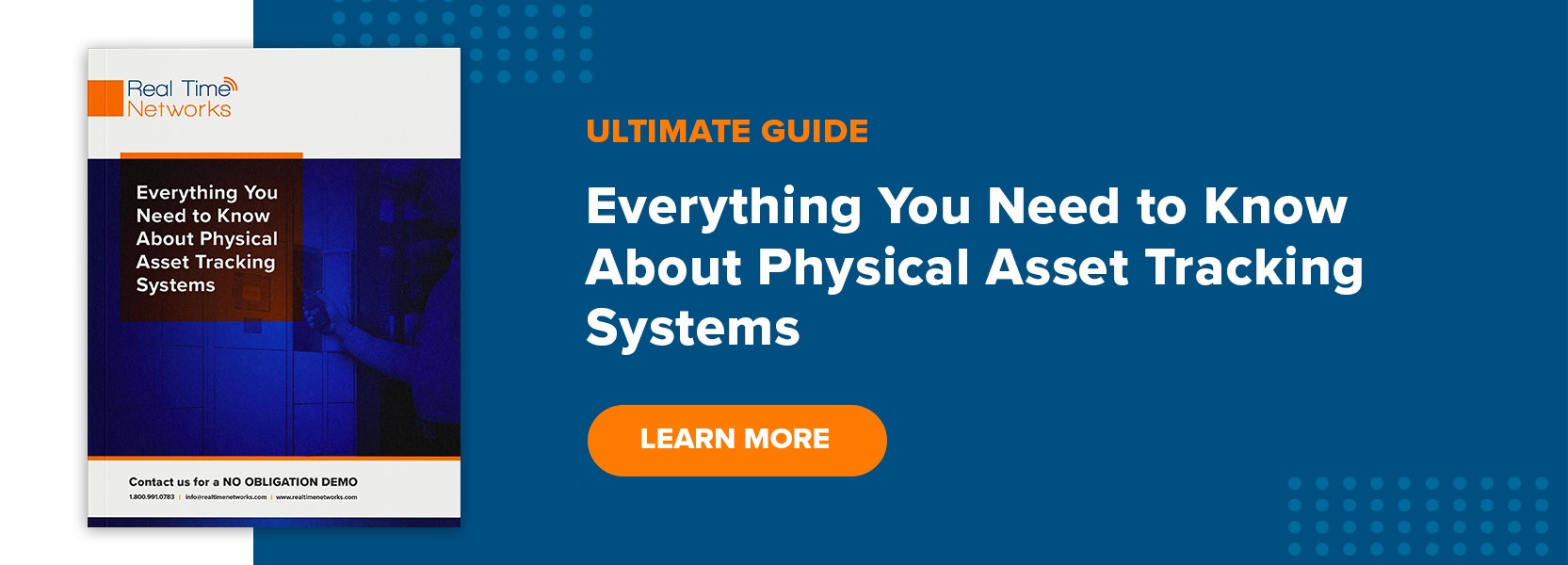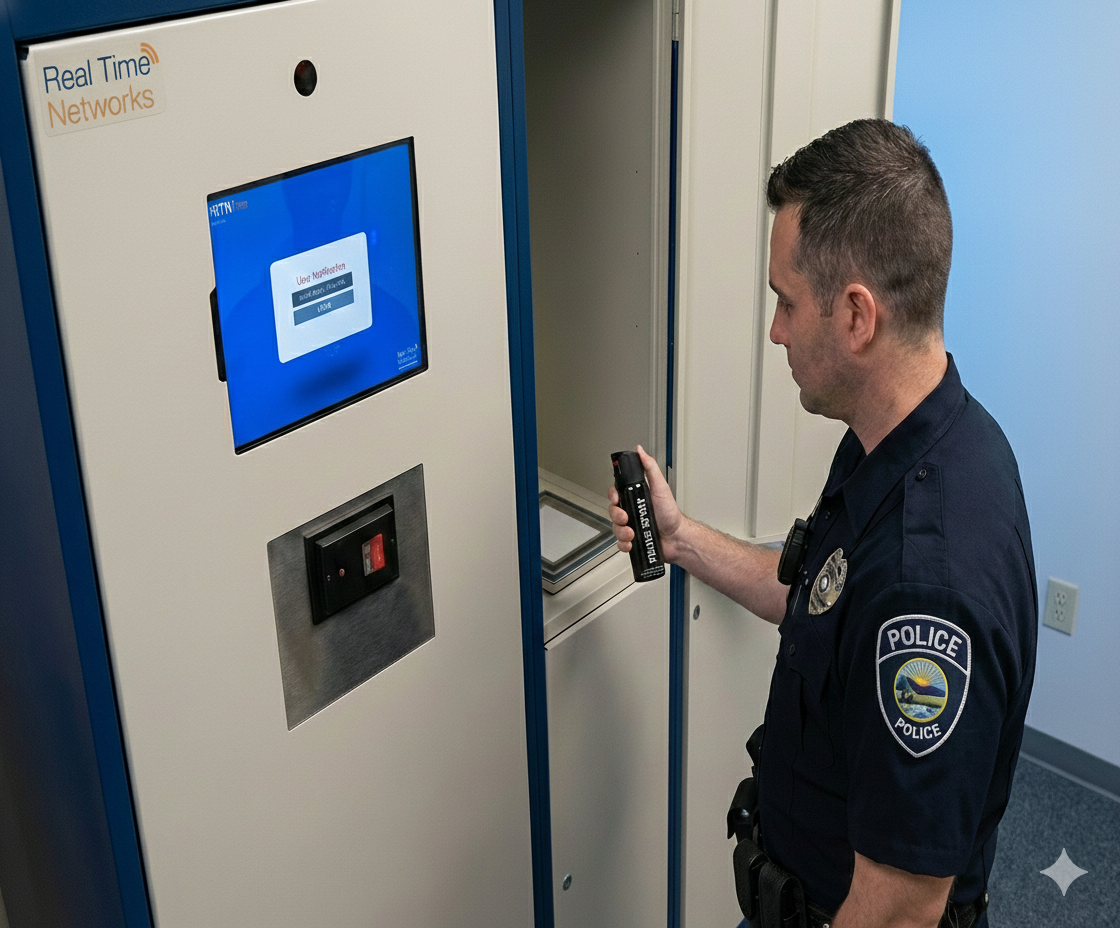By Jay Palter | July 6, 2022
Locker systems are excellent tools for managing equipment. And the “smarter” your lockers get, the more effective they become. Adding asset surveillance to your equipment tracking system is an excellent way to improve its effectiveness.
Table of Contents
Asset surveillance systems—like those available in our AssetTracer smart lockers for asset tracking—connect physical lockers with equipment tracking software and our other real-time security systems. Whole new workflows are possible when these tools are integrated.
Different types of asset surveillance make sense in different environments. This article unpacks how asset surveillance systems work in smart lockers and shares some use cases for asset surveillance. It also helps determine what type of asset surveillance makes sense for your equipment tracking system.
What Is an Equipment Tracking System?
Equipment tracking systems verify that a user takes or returns the correct items from a storage locker. They can also provide data on electronic devices. For example, most electronic devices that charge with a USB port can identify themselves when plugged into a locker. This way, they’re both recharged at rest, and their status is verified.
Asset surveillance is just one of the ways you can use electronics and sensors to make a locker system “smart.” To explain, let’s consider the opposite: a standard storage locker. It is a metal cabinet with a mechanical lock. It is effective, but it can’t tell you very much about who is using it and what is inside of it. It is a little dumb.
If you add an electronic access control panel to that locker, suddenly, you get better insights on who is accessing your equipment and when they sign it out and return it. So that is a little smarter.
Finally, you can add equipment surveillance. You can verify what people take from the locker when recording a transaction. Did they take everything they needed and return the wrong item? With asset surveillance, you’ll know instantaneously.
The goal of any asset surveillance is to provide better insight into the asset and its use. By logging transactions, a smart locker system is already a source of business intelligence. But adding asset surveillance turns assets themselves into information sources.
Equipment Tracking Methods
AssetTracer systems from Real Time Networks can use various asset surveillance technologies.
Barcodes
Barcodes are a basic asset surveillance technology that gives you a good amount of insight into asset usage. Their main drawback is that they require line of sight scanning to work and so usually require active, manual scanning when a user takes or returns a device from a locker.
USB connections
Most lockers on the market can now offer USB charging for electronic devices right in the locker. But some advanced systems, like AssetTracer, can use that USB connection to verify the device’s identity and sometimes even its status, depending on the operating system in use.
RFID tags
Radiofrequency identification tags have the benefit of transmitting through plastic and fabric, which means you can scan multiple tags at once inside kit bags and cases. In addition, RFID sensors located inside lockers can scan multiple tags at once, so you can instantly verify whether every kit component is taken or returned.
Photos
Photos don’t provide real-time physical asset tracking like the other methods listed here but offer an enhanced control level. For example, advanced equipment tracking systems can have cameras embedded in their access terminal. That terminal can photograph the user and the equipment they sign in or out. That can help you verify what an individual took from the locker system after the fact.
When You Need an Equipment Tracking System
Any organization using asset lockers cares about security. But businesses that benefit from equipment tracking systems care just as much, if not more, about how their assets are used.
An asset surveillance system lets you build workflows around the real-time availability of different assets. For example, you can restrict access based on the specific staff member signing the asset out, by the time of day, or by other criteria. You may want to rotate sign-outs to distribute wear and tear if you need to provision rugged laptops for heavy-duty field use.
With a asset surveillance system, your smart locker system can verify which laptop is in which locker and how many hours of use each has received. Then the system will only unlock the laptop with the least use.
That’s just one example. You can improve a whole range of workflows:
Verifying chain of custody
Smart lockers can track who signs an asset in or out. But without asset surveillance, they can’t verify what is taken or returned from the locker or if anything is returned at all. So, for example, a disgruntled employee could sign a laptop back in at the locker terminal but then just keep it with them when they walk out the door on their last day.
If assets are particularly sensitive, expensive, or regulated, a real-time asset surveillance system can confirm whether they’ve been returned. And instantly notify supervisors if they’re not for time-sensitive responses. Without that automated verification, it may not be until the next shift or even days later that a mission-critical device is found missing.
Maintaining a detailed chain of custody like that is one of the reasons more and more smart lockers are used in evidence management. As a result, officers can deposit evidence any time of day and include detailed notes in evidence submissions safely and securely, without an evidence manager needing to be on duty.
Kit component checks
As mentioned earlier, asset surveillance systems can detect multiple items in hardened carrying cases. Some organizations want—or need—to ensure that individual components are returned, like medication, controlled substances, or government-regulated materials.
Asset surveillance can notify EMTs if life-saving medications are missing from a kit bag before they go on a call. Or notify supervisors if a regulated narcotic is missing upon return.
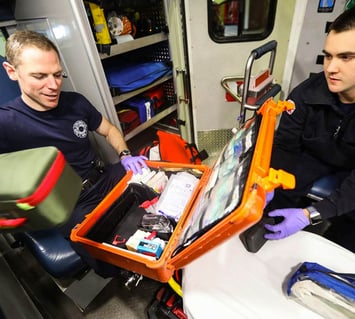
Temporary storage
Some law enforcement agencies and medical centers need a way to temporarily secure the assets of individuals coming into their facilities, like patients or suspects. The officer or technician escorting that individual can register a locker in that individual's name, deposit their assets, and give them a unique code only they can use to unlock the locker. The locker becomes free for the next us when that individual claims their assets.
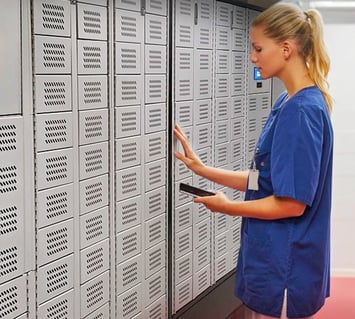
Compliance reporting
If you’re managing regulated equipment, medications, or other assets, you probably need to account for them in compliance reports. These reports are easily and automatically compiled by smart locker management apps in real-time as asset transactions occur.
Or, as we discussed in a previous smart lockers article, alternate forms of asset surveillance, like scales for weight checks, can measure and verify assets upon return. That automates an important compliance task for law enforcement agencies who must verify whether OC (pepper) spray cans have been used by checking their weight.
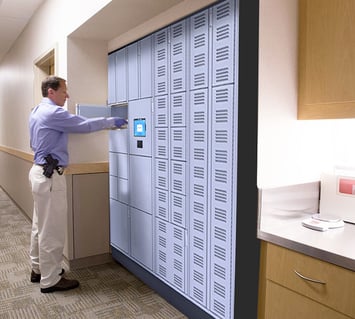
Power management
Smart lockers can also distribute electronic devices according to which ones are most charged. Simply set your asset system to unlock the longest-held device of a given type when someone wants one. Then, they’ll automatically get the most fully-charged device.
Automating workflows
If IT teams need to be notified of break-fix issues as soon as laptops, tablets, or other assets return from the field, you can turn smart lockers into a service tool for them. For example, when a staff member returns an asset, the touchscreen interface on the smart locker can prompt them to log any issues encountered.
For laptops, for example, it could be anything from a crashing application to an entirely dead device. That logging triggers an email alert to the IT team and unlocks a designated service locker. The asset surveillance system then ensures that the specific device the user signed out is placed in the service locker.
This general workflow—a staff-entered code triggering a specific locker opening—can be used for other assets that need attention, like supply kits that need restocking, firearms that need maintenance, or delicate instruments that need cleaning.
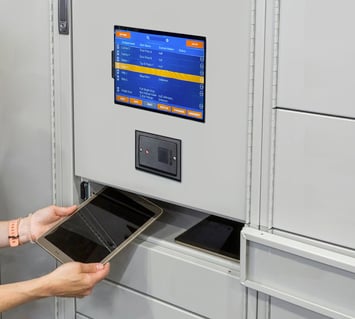
How to Choose the Right Equipment Tracking System
Asset surveillance is powerful, but not every organization needs it. If your organization is concerned about theft, RFID tagging is the best choice. If theft isn’t a concern, then a more basic tagging system like barcodes or USB connections are sufficient.
You can also consider how many assets you store per compartment. If you’re storing more expensive, dangerous, or sensitive assets, plan to only house one per compartment. For medium levels of security, you could also tag each component with an RFID chip and store multiple assets per compartment. You’d give users physical access to all housed assets, but you’d know instantly if they signed out more than they requested.
If keeping staff accountable for their transactions is important, even if the value of the assets is low, then basic asset lockers again should be sufficient. Even without asset surveillance, basic asset lockers still provide useful data through access control reporting, like our RTNHub equipment management app. For complying with some industry regulations, this level of reporting is sufficient.
Still not sure what smart locker solution you need?
Contact Real Time Networks today for a risk-free, no-obligation consultation.Subscribe to our blog

Jay Palter
Vice President of Marketing & Partnerships
